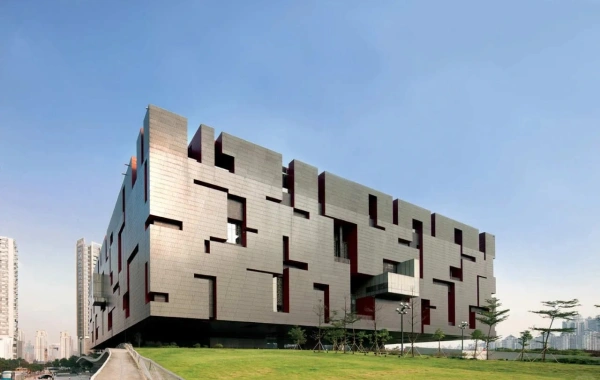Guangdong Museum
Guangdong Museum
The Guangdong Museum, located in Guangzhou, is one of the most prominent cultural institutions in southern China, dedicated to preserving and showcasing the rich history, art, and natural heritage of Guangdong Province. Established in 1959 and relocated to its current modern building in 2010, the museum spans over 67,000 square meters and houses over 160,000 cultural relics, including ancient ceramics, bronze artifacts, maritime trade items, and folk art. Its sleek, contemporary design, inspired by traditional Cantonese architectural elements, symbolizes Guangdong’s blend of tradition and modernity. Designated a national first-grade museum, it serves as a vital center for education, research, and cultural exchange.

Historical Overview
The Guangdong Museum traces its origins to the 1920s when local scholars began collecting and exhibiting regional artifacts. The current institution was formally established in 1959, initially housed in a historic building in Guangzhou’s Yuexiu District. In 2010, it moved to its iconic new facility in Zhujiang New Town, designed to reflect Guangdong’s maritime heritage and innovative spirit. Over the decades, the museum has played a pivotal role in preserving Guangdong’s cultural identity, documenting its role in the Maritime Silk Road, the Opium Wars, and its status as a frontier of modern Chinese reform. Key milestones include the 1980s expansion of its collections and the 2010 reopening as a world-class museum.
Structural Layout
The museum’s design features a dynamic, undulating form inspired by traditional Cantonesse pottery kilns and the Pearl River Delta’s waterways. It is organized into four main floors:
- Basement: Temporary exhibition halls and educational spaces.
- Ground Floor: Entrance lobby, visitor services, and the “Guangdong History” gallery.
- Second Floor: “Natural Resources” and “Maritime Trade” galleries, highlighting Guangdong’s ecological diversity and global connections.
- Third Floor: “Folk Culture” and “Fine Arts” galleries, showcasing Traditional Crafts, costumes, and contemporary art.
Key areas include the Grand Atrium, a soaring central space with natural light, and the Rooftop Garden, offering views of Guangzhou’s skyline.

(Vipassana)
Major Attractions
- Guangdong History Gallery: Traces the province’s development from prehistoric times to the present, featuring Neolithic tools, Tang Dynasty ceramics, and revolutionary artifacts.
- Maritime Silk Road Gallery: Displays Porcelain, silverware, and ship models from Guangdong’s medieval trade networks, which linked China to Southeast Asia, the Middle East, and Africa.
- Cantonese Opera Costume Exhibition: Showcases intricately embroidered garments and props used in this UNESCO-listed performing art.
- Natural Resources Hall: Features geological specimens, dinosaur fossils, and dioramas of Guangdong’s ecosystems, including mangrove forests and South China Sea coral reefs.
- Modern Art Gallery: Highlights works by Guangdong-born artists such as Lin Fengmian and Guan Shanyue, as well as contemporary installations exploring urbanization and globalization.
- Treasure Hall: Exhibits rare artifacts, including a golden belt from the Nanyue Kingdom and a jade burial suit from the Han Dynasty.
Suggested Itineraries
- Classic Route (2–3 hours):
- Entrance → Guangdong History Gallery → Maritime Silk Road Gallery → Cantonese Opera Exhibition → Treasure Hall → Exit.
Highlights: Key historical and cultural exhibits.
- Entrance → Guangdong History Gallery → Maritime Silk Road Gallery → Cantonese Opera Exhibition → Treasure Hall → Exit.
- Extended Route (4–5 hours):
- Entrance → Natural Resources Hall → Guangdong History Gallery → Maritime Silk Road Gallery → Folk Culture Gallery → Modern Art Gallery → Rooftop Garden → Exit.
Highlights: Addition of natural history and contemporary art sections.
- Entrance → Natural Resources Hall → Guangdong History Gallery → Maritime Silk Road Gallery → Folk Culture Gallery → Modern Art Gallery → Rooftop Garden → Exit.
- Comprehensive Route (Full Day):
- Entrance → All permanent galleries (History, Maritime Trade, Natural Resources, Folk Culture, Fine Arts) → Temporary Exhibitions → Educational Workshops → Rooftop Garden → Exit.
Highlights: In-depth exploration of all collections, including interactive activities.
- Entrance → All permanent galleries (History, Maritime Trade, Natural Resources, Folk Culture, Fine Arts) → Temporary Exhibitions → Educational Workshops → Rooftop Garden → Exit.

Ticket Purchase
- Online: Book via the official Guangdong Museum website or WeChat mini-program (up to 7 days in advance).
- On-Site: Tickets are available at the entrance, but queues may be long during peak hours.
- Prices: Free admission (temporary exhibitions may require a separate fee).
- ID Requirement: Visitors must present a valid ID (passport, Chinese ID card) for entry.
- By Subway:
- Line 3 or 5 to Zhujiang New Town Station (Exit B1), walk 5 minutes to the museum.
- By Bus:
- Routes 40, 44, 138, or 886 to Guangdong Museum Stop.
- By Taxi: Direct to the museum’s main entrance (address: No. 2 Zhujiang East Road, Tianhe District).
- Parking: Available on-site (fee required).
Best Time & Tips
- Peak Hours: Avoid 10 AM–2 PM on weekends and holidays; visit early (9 AM opening) or late afternoon.
- Crowds: Weekdays are quieter; reserve tickets in advance for temporary exhibitions.
- Weather: Year-round access, but spring (March–May) and autumn (October–November) are most comfortable.
- Essentials:
- Wear comfortable shoes (the museum is large).
- Bring a water bottle (refill stations available).
- Photography allowed (no flash in designated areas).
- Prohibited items: Large bags, tripods, and selfie sticks (lockers available).
- Download the museum’s app for audio guides and maps.
Contact Us
What Our Clients Say?
Based on 10,000+ traveler reviews













